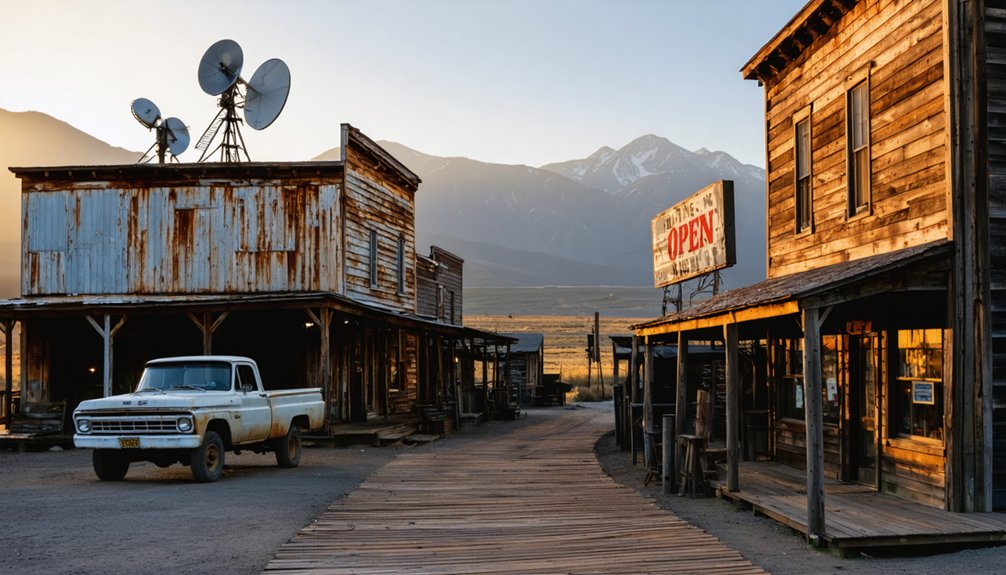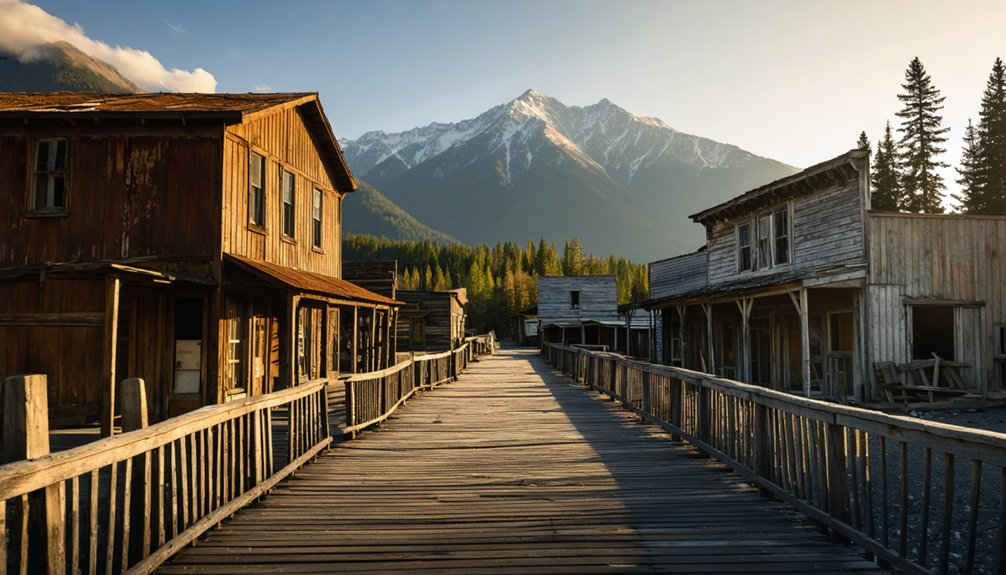You’ll find Idaho City nestled in the Boise Basin, where an 1862 gold discovery sparked one of the West’s richest rushes, swelling the population to 7,000. Despite four devastating fires in the 1860s, this resilient town rebuilt itself each time, shifting from wooden structures to brick and stone. Today, 536 residents maintain the historic character of their community, where original 1860s buildings tell tales of mining fortunes, Chinese heritage, and frontier determination.
Key Takeaways
- Idaho City is not a ghost town, but rather an active community with 536 residents and a thriving heritage tourism industry.
- The town experienced a dramatic population decline from its 1864 peak of 7,000 residents during the gold rush era.
- Historic structures from the 1860s remain preserved, including St. Joseph’s Catholic Church and the oldest operating Masonic Lodge.
- The town maintains its historical character through museums, guided tours, and well-preserved buildings from its mining heyday.
- The community has successfully transitioned from a mining economy to a tourist destination while preserving its gold rush heritage.
The Birth of a Mining Boomtown
When George Grimes and Moses Splawn’s party discovered gold on Grimes Creek in August 1862, they set off a chain of events that would transform the Boise Basin forever. The discovery party returned to Walla Walla with five thousand dollars in gold.
Within months, miners rushed to the area, establishing what would become Idaho City on October 7th. You’d have found early mining techniques yielding incredible returns – $8 to $20 daily, with lucky prospectors hitting $100 to $200. The area’s prosperity attracted numerous businesses, with bakeries and doctors establishing shops by 1863.
The community dynamics shifted rapidly as the settlement grew from a mining camp into the Pacific Northwest’s largest city.
Fires and Rebuilding: A Town’s Resilience
While Idaho City’s early prosperity brought rapid growth, the town’s wooden infrastructure proved devastatingly vulnerable to fire. During the 1860s and early 1870s, four major fires ravaged the community, with the most destructive blaze erupting on May 18, 1865. Starting in a dance hall, flames devoured pine structures lined with cotton and paper, causing $900,000 in damages. Some opportunistic individuals used the chaos to their advantage as thieves stole goods while pretending to assist with evacuation efforts. The Sheriff quickly appointed special deputies to maintain order during the chaos.
You’ll find that Idaho City’s pioneers weren’t easily defeated. After each disaster, they’d rebuild within weeks, housing the displaced in surviving structures like the Catholic Church.
They learned from experience, switching from wood to brick and stone construction to improve fire safety. Their community resilience paid off – while later fires still occurred, they remained isolated incidents rather than town-wide catastrophes.
Today, several original buildings, including the mysterious fire-surviving Masonic Hall, still stand.
Chinese Heritage and Cultural Impact
As gold fever drew thousands to Idaho City in the 1860s, a vibrant Chinese community emerged that would shape the town’s cultural landscape for decades.
By 1870, Chinese residents made up over 45% of the population, creating a thriving Chinatown where you’d find traditional herbs, specialty goods, and authentic cuisine.
Despite facing harsh discrimination, including unfair taxes and legal restrictions, Chinese entrepreneurs like Pon Yam made significant economic contributions through their businesses and mining operations. The Idaho Territorial Legislature enforced a discriminatory monthly tax of $5 on all Chinese residents.
Their cultural identity flourished through celebrations of Lunar New Year and community gatherings.
Most immigrants came from Guangdong Province, seeking opportunities amid social and economic upheaval in China.
You’ll find their influence woven throughout the town’s history, from the mining claims they worked to the commercial district where they built successful enterprises.
Though violent anti-Chinese sentiment eventually diminished their numbers, their legacy endures in Idaho City’s story.
Preserving the Past: Historical Landmarks
Throughout Idaho City’s storied past, preserving historical landmarks has remained an essential mission for local organizations and community members.
You’ll find the town’s commitment to cemetery preservation at Boot Hill, where over 2,000 burials tell stories of the mining era’s diverse community, from Chinese settlers to Masonic lodge members.
The architectural significance of Idaho City shines through its carefully maintained 1860s structures. Like many of Idaho’s ghost town destinations, Idaho City offers visitors a chance to explore authentic remnants of the American West.
Founded in 1862 during the gold rush era, the town quickly grew into a bustling mining settlement that attracted thousands of prospectors seeking their fortunes.
You can explore the 1867 St. Joseph’s Catholic Church, the 1865 Masonic Temple, and uniquely constructed buildings set on pilings that once allowed mining underneath.
The Boise Basin Museum and Diamond Lil’s offer you glimpses into the past through authentic artifacts, while the Sluice Box stands as a symbol of the town’s preservation efforts, complete with its own mysterious tales.
From Gold Rush to Tourism Haven
You’ll find that Idaho City’s dramatic transformation from an 1862 gold rush boomtown into today’s heritage tourism destination mirrors the broader story of the American West.
During its peak in 1864, the city generated extraordinary wealth with miners earning up to $200 daily, establishing it as the Northwest’s largest city with over 7,000 residents. The city’s population included a substantial Chinese mining community that contributed significantly to the region’s development.
Now, while the gold has long since been extracted, you can explore the well-preserved historic structures and mining artifacts that draw visitors seeking to experience this fascinating chapter of Idaho’s frontier history.
Mining’s Early Economic Impact
When George Grimes and Moses Splawn discovered placers in the Boise Basin in August 1862, they sparked one of the largest gold rushes since California’s famous boom. The economic significance of their discovery was immediately apparent, with miners earning an astounding $8 to $200 per day.
By fall 1862, you’d find prospectors pulling in an average of $18 per pan, with some lucky strikes yielding up to $80.
The mining prosperity transformed the region rapidly. Within months, boomtowns like Placerville, Centerville, Pioneerville, and Idaho City sprouted up to support the rush.
Tourism Preserves Historic Legacy
Today’s Idaho City stands as a symbol of the enduring spirit of its gold rush origins, transforming from a bustling mining hub into a cherished historic destination.
You’ll find heritage conservation at work throughout the town, which earned its place on the National Register of Historic Places in 1975. The Idaho City Historical Foundation actively preserves architectural treasures like the Boise County Courthouse and Pon Yam House, connecting you to the area’s diverse cultural past.
Cultural tourism drives the local economy, creating jobs and breathing new life into historic buildings. The town’s population has drastically changed from its peak of over 6,000 residents during the mining era.
You can explore the Pioneer Cemetery‘s 2,000 graves, participate in historical reenactments, or visit the Boise Basin Museum. Local residents serve as passionate stewards of their history, offering guided tours and organizing community events that keep the town’s rich heritage alive.
Balancing Past and Present
The remarkable transformation of Idaho City from a booming 1860s gold rush settlement into a modern tourist destination reflects the delicate balance between preserving its historic legacy and embracing economic evolution.
You’ll find evidence of this economic adaptation throughout the town, where mining claims once yielding $80 per pan have given way to heritage tourism.
While the population has drastically changed from its peak of 7,000 in 1864, cultural preservation efforts now showcase the diverse stories of pioneers, Chinese miners, and Native American interactions.
The town’s shift from gold to timber in the early 1900s demonstrated its resilience, and today’s Idaho City continues this tradition of reinvention while maintaining authentic connections to its past through archaeological sites, historic graveyards, and carefully preserved architectural remnants.
Life in Modern-Day Idaho City

When you visit Idaho City today, you’ll find a vibrant community of 536 residents who’ve maintained their town’s historic character while embracing tourism as their economic backbone.
You can explore well-preserved Gold Rush-era buildings alongside modern homes, where 86% of residents own their properties and contribute to the town’s close-knit atmosphere.
The community’s blend of historical tourism and small-town lifestyle shows in the local events that celebrate Idaho City’s mining heritage, while residents enjoy a quiet pace of life with easy access to outdoor recreation and Boise’s urban amenities.
Tourism Drives Local Economy
Despite its modest population, modern Idaho City thrives on a robust tourism industry that’s transformed this historic mining town into a heritage destination.
You’ll find tourism sustainability efforts reflected in the town’s year-round attractions, from guided history walks to local artisan markets that preserve authentic ghost town character.
The town’s economic diversification is evident in its growing hospitality sector, where historic hotels, restaurants, and specialty shops cater to visitors throughout the year.
You’ll notice peak activity during summer and fall when heritage tours and festivals draw the largest crowds.
Tourism has created numerous local jobs, with state initiatives pumping millions into regional development.
Through lodging taxes and visitor spending, you’re contributing to a $5.5 billion statewide tourism economy that’s keeping Idaho City’s history alive.
Small-Town Charm Remains
Modern life in Idaho City perfectly balances small-town intimacy with sustainable growth, as evidenced by its stable population of 536 residents and strong 80% homeownership rate.
You’ll find a close-knit community where nearly 75% of residents live in family units, fostering deep connections through small town festivals and regular community gatherings.
Despite its historic roots, Idaho City isn’t stuck in the past.
You’ll see steady economic progress with household incomes growing at 1.35% annually, while maintaining an impressively low 3.4% family poverty rate.
The demographic makeup remains diverse yet stable, with a median age of 38.8 years and a healthy mix of young families and seniors.
This careful preservation of small-town values, combined with measured growth, guarantees Idaho City’s charm won’t fade anytime soon.
Historic Buildings Still Standing
The heart of Idaho City’s enduring legacy stands proudly in its historic buildings, with many original structures dating back to the 1860s gold rush era still serving the community today.
You’ll find remarkable examples of architectural significance in the Masonic Temple, built in 1865 and recognized as the oldest operating lodge west of the Mississippi.
Historic preservation efforts have kept treasures like St. Joseph’s Catholic Church (1867), the Jenny Lind Theater, and the I.O.O.F. Hall intact.
The Boise Basin Museum, housed in the original post office, showcases mining artifacts, while Diamond Lil’s maintains its historic saloon character.
Walking through town, you’ll discover the Assay Office, old courthouse, and remnants of Chinese heritage buildings, each telling stories of Idaho City’s vibrant past through their carefully maintained facades and repurposed spaces.
Frequently Asked Questions
What Happened to the Original Territorial Documents After the 1865 Fire?
You’ll find that the territorial archives’ fate remains unclear, as there’s no direct evidence of what happened after the fire impact – they were likely destroyed or relocated, but historical records don’t confirm either.
Are There Any Active Gold Mining Claims Near Idaho City Today?
You’ll find thousands of active gold mining claims scattered around Idaho City today, with over 1,171 claims recorded. Under current claim regulations, you’re free to buy, sell, and work these treasures.
How Much Gold Was Discovered in Total During the Boom Years?
During the gold rush years from 1863-1959, you’ll find records showing an incredible 2.8 million ounces of gold discovered, worth about $250 million in mining history’s most prosperous era.
What Supernatural Legends or Ghost Stories Are Associated With Idaho City?
You’ll find surprisingly few documented haunted locations or ghost sightings, though locals whisper about the old cemetery’s spirits and historic buildings. The town’s violent past fuels speculation, but evidence remains scarce.
Where Did Most of the Chinese Residents Relocate After Leaving Idaho City?
You’ll find most Chinese residents moved to Boise in the 1880s during a significant Chinese migration, establishing vibrant Chinatowns and making a lasting cultural impact through businesses, community events, and trade networks.
References
- https://idaho-forged.com/idahos-ghost-towns-eerie-yet-approachable/
- https://www.legendsofamerica.com/idaho-city-idaho/
- http://www.ghosttowngallery.com/htme/idahocity.htm
- https://storymaps.arcgis.com/stories/3b6f3a8272054a55b40e4dc6a6380231
- https://www.youtube.com/watch?v=uDHvGbb-Sq4
- https://en.wikipedia.org/wiki/Idaho_City
- https://visitidaho.org/things-to-do/ghost-towns-mining-history/idaho-city-historical-area/
- https://idahocityhistoricalfoundation.org/?page_id=147
- https://visitidaho.org/things-to-do/ghost-towns-mining-history/
- https://westernmininghistory.com/towns/idaho/idaho-city/



